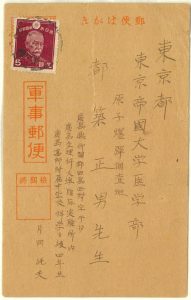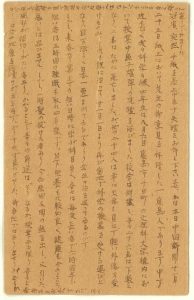Documenting Hiroshima of 1945: November 25, worries about health of A-bombed students
Nov. 25, 2024
by Kyosuke Mizukawa, Senior Staff Writer
On November 25, 1945, the Chugoku Shimbun newspaper carried an article with the headline, “Even if symptoms improve, do not overexert yourself this winter.” That was from a conversation with Masao Tsuzuki, a specialist in radiation medicine at Tokyo Imperial University (present-day University of Tokyo) who had been investigating damages from the atomic bombing of Hiroshima.
Mr. Tsuzuki pointed out that the damage to those who were outdoors at the time of the bombing was particularly noteworthy, and even those who were indoors were “considered to have been exposed to a certain amount [of radiation].” He also explained his view at the time that those who had been within a one-kilometer radius of the hypocenter were difficult to treat, while those who had been between one and two kilometers would “heal to some extent by treatment.”
Around that time, the decrease observed in white blood cell count due to acute radiation sickness started to show signs of recovery. Nonetheless, Mr. Tsuzuki urged survivors “to take care not to overexert yourselves or catch a cold for another six months, especially this winter. You should not feel reassured just because your white blood cell count has increased.”
Held at the Hiroshima Municipal Archives is a postcard sent to Mr. Tsuzuki from a student who had grown worried after reading the article. The sender was “Sumio Kataoka,” a fourth-year student in a special science course at the junior high school affiliated with the Hiroshima Higher Normal School (present-day Hiroshima University Junior and Senior High School).
The special science course was established as part of national policy during the war. Twenty-six fourth-year students experienced the atomic bombing at the school building in the area of Higashisenda-machi (in Hiroshima’s present-day Naka Ward), located around 1.5 kilometers from the hypocenter. “Mr. Kataoka” wrote that he had had been trapped under the collapsed school building and that two of his classmates had died. He also conveyed the information that among the students who had survived, “some had temporary hair loss.”
Classes resumed in November after they had been relocated to present-day Onomichi City. He wrote in his letter that “even now, some of the students have developed fevers of unknown origin, and others with colds have had difficulty in recovering completely.” Meanwhile, he also wrote that some students were getting by on less than five hours of sleep because they were studying for graduation in the spring. He asked Mr. Tsuzuki, “What should we do?”
In actual fact, the sender’s name “Sumio Kataoka” was a combination of the family name of Jiro Kataoka and the first name of Sumio Yamanoue. The two were best friends as fourth-year students in the special science course. Mr. Yamanoue later became a reporter for the Mainichi Shimbun newspaper and died in 2021 at the age of 92. The previous year, he had published a book titled Hiroshima wo Ikite (in English, ‘Surviving the A-bombed Hiroshima’), his personal account of the atomic bombing, which was serialized in the Mainichi Shimbun. Jiro Kataoka died of cancer in his 30s, writing that his death “must be the result of the aftereffects of the atomic bombing.”
(Originally published on November 25, 2024)
On November 25, 1945, the Chugoku Shimbun newspaper carried an article with the headline, “Even if symptoms improve, do not overexert yourself this winter.” That was from a conversation with Masao Tsuzuki, a specialist in radiation medicine at Tokyo Imperial University (present-day University of Tokyo) who had been investigating damages from the atomic bombing of Hiroshima.
Mr. Tsuzuki pointed out that the damage to those who were outdoors at the time of the bombing was particularly noteworthy, and even those who were indoors were “considered to have been exposed to a certain amount [of radiation].” He also explained his view at the time that those who had been within a one-kilometer radius of the hypocenter were difficult to treat, while those who had been between one and two kilometers would “heal to some extent by treatment.”
Around that time, the decrease observed in white blood cell count due to acute radiation sickness started to show signs of recovery. Nonetheless, Mr. Tsuzuki urged survivors “to take care not to overexert yourselves or catch a cold for another six months, especially this winter. You should not feel reassured just because your white blood cell count has increased.”
Held at the Hiroshima Municipal Archives is a postcard sent to Mr. Tsuzuki from a student who had grown worried after reading the article. The sender was “Sumio Kataoka,” a fourth-year student in a special science course at the junior high school affiliated with the Hiroshima Higher Normal School (present-day Hiroshima University Junior and Senior High School).
The special science course was established as part of national policy during the war. Twenty-six fourth-year students experienced the atomic bombing at the school building in the area of Higashisenda-machi (in Hiroshima’s present-day Naka Ward), located around 1.5 kilometers from the hypocenter. “Mr. Kataoka” wrote that he had had been trapped under the collapsed school building and that two of his classmates had died. He also conveyed the information that among the students who had survived, “some had temporary hair loss.”
Classes resumed in November after they had been relocated to present-day Onomichi City. He wrote in his letter that “even now, some of the students have developed fevers of unknown origin, and others with colds have had difficulty in recovering completely.” Meanwhile, he also wrote that some students were getting by on less than five hours of sleep because they were studying for graduation in the spring. He asked Mr. Tsuzuki, “What should we do?”
In actual fact, the sender’s name “Sumio Kataoka” was a combination of the family name of Jiro Kataoka and the first name of Sumio Yamanoue. The two were best friends as fourth-year students in the special science course. Mr. Yamanoue later became a reporter for the Mainichi Shimbun newspaper and died in 2021 at the age of 92. The previous year, he had published a book titled Hiroshima wo Ikite (in English, ‘Surviving the A-bombed Hiroshima’), his personal account of the atomic bombing, which was serialized in the Mainichi Shimbun. Jiro Kataoka died of cancer in his 30s, writing that his death “must be the result of the aftereffects of the atomic bombing.”
(Originally published on November 25, 2024)









